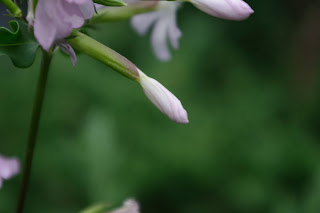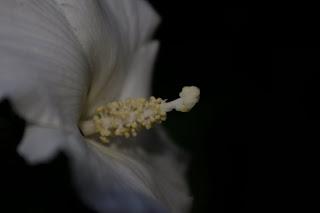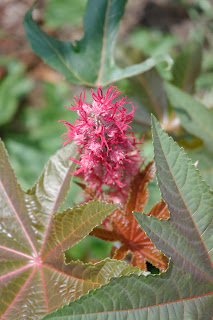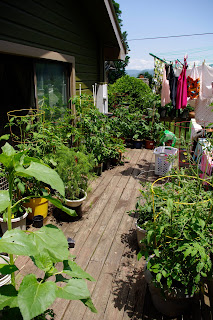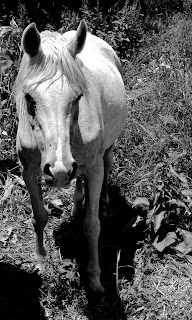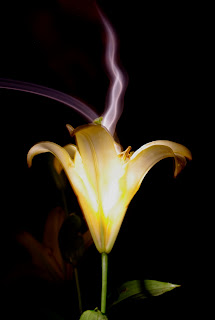One of the amazing things about gardens and plants in general is that you can usually find something amazing if you just look a little closer. Case in point, this Phlox paniculata, or garden phlox, that's growing at the end of the driveway. Beautiful plant, but if you look closely, you get these incredible flowers that haven't opened yet, rolled up in a neat little spiral.
These will open up tomorrow or the next day, but they're so neat just like this, and most people never notice them.
Once these flowers open, they are a big hit with the neighborhood butterflies and bees, and make a great garden specimen. Very tall, stout plants with big clusters of flowers and nice foliage. They especially look good in masses with hordes of butterflies feeding on them. They are also fairly easy to propagate, which I'll get to in a later post. For now, just remember to always look closely at the plants in the yard; some of them have hidden beauty.
Sunday, August 7, 2011
Thursday, July 28, 2011
Morning Treats
Sometimes, (well, a lot of the time), the best part of all this gardening is the all the beautiful stuff there is to look at. This morning, I was out the door at 6:30 to water the raised beds before the heat of the day got here. There was a nice, muted sunrise through the trees.
Loads of flowers to admire.
Even the dill was flowering.
A dead seedhead from an early season allium still looks gorgeous.
Taking just a few minutes to really look at all this beauty makes the day a lot easier to deal with.
Loads of flowers to admire.
Even the dill was flowering.
A dead seedhead from an early season allium still looks gorgeous.
Taking just a few minutes to really look at all this beauty makes the day a lot easier to deal with.
Sunday, July 24, 2011
Basement Finds
In a fit of desperation, I decided to clean the basement... After two full days, one really big molted snakeskin in the rafters and an untold multitude of spiders, it's starting to look like... Well, it looks better, at least. In addition to finding a six pack of beer that was out of date by three years, I also stumbled on a couple of other things of interest.
Laundry and crafts. Wow.
It appears she may have burned her face a little on that hot wax...
Also, iron horses and oil lamps. Yes, my basement is still living in the early 1900's...
Laundry and crafts. Wow.
It appears she may have burned her face a little on that hot wax...
Also, iron horses and oil lamps. Yes, my basement is still living in the early 1900's...
Friday, July 22, 2011
The Tree Shelf
The big project for the week was to remove a small, cramped closet from the kids' room, freeing up some valuable floor space. As usual, I completely forgot to take an actual "before" picture, so here's a shot from early in the process: The old closet is gone, the walls and ceilings repaired, but still no flooring.
A few years ago, we painted a tree on the wall over my daughters bed:
To tie in the corners of the room, we built a tree shelf for the newly-liberated corner.
This is the frame and a few slats of wood, the beginnings of the base and the bark of our tree.
Once all the slats are on, we end up with something like this.
A little paint:
And we end up with a finished base:
Base + shelves = the beginnings of a nice little project.
A top was built for our little tree, following the same procedure as the base, then attached and painted. A little detail work later and, Voila! Tree shelf!
A lot of the materials for this project were reclaimed from the torn-down closet. The paint was left over from the previous tree-related project, and the carpet was scrap. I bought a couple of pieces of thin plywood for the bark, but this was still a cheap and relatively easy project that the kids seem to like.
A few years ago, we painted a tree on the wall over my daughters bed:
To tie in the corners of the room, we built a tree shelf for the newly-liberated corner.
This is the frame and a few slats of wood, the beginnings of the base and the bark of our tree.
Once all the slats are on, we end up with something like this.
A little paint:
And we end up with a finished base:
Base + shelves = the beginnings of a nice little project.
A top was built for our little tree, following the same procedure as the base, then attached and painted. A little detail work later and, Voila! Tree shelf!
A lot of the materials for this project were reclaimed from the torn-down closet. The paint was left over from the previous tree-related project, and the carpet was scrap. I bought a couple of pieces of thin plywood for the bark, but this was still a cheap and relatively easy project that the kids seem to like.
Wednesday, July 13, 2011
Tuesday, July 12, 2011
On topics of gastronomy
I had a post to make a week or so ago, and then things got busy, and, well, you know...
Food and/or cooking may not seem to be directly related to gardening, but we do a lot of cooking here; using produce from the garden or the farmers market and eggs from our flock, so there is some relationship there. I'm not going to turn this into a cooking blog, but I think it's nice to occasionally celebrate the fruits of our gardening labors.
For the Fourth, we, like millions of other people, grilled out. Nothing super fancy, just barbecued chicken with homemade barbecue sauce. Secret BBQ sauce ingredient? Dr. Pepper. Nice amount of sweetness and acidity. Looks pretty good, eh?
Just look at those grill marks...
There were some good sides as well: Smoked trout potato salad, broccoli salad and grilled corn on the cob.
To minimize a preponderance of food related posts, I'll stick tonight's meal in here as well. Fried green tomato BLT with cheesy grits and broccoli. The tomatoes were home grown and the broccoli came from the farmers market.
The sandwich was sublime. Toasted sourdough, homemade remoulade, crispy bacon, cold lettuce, green tomatoes dipped in buttermilk and cornmeal and a slice of fresh, ripe tomato. I'm sweating bacon, and I mean that in a good way.
Food and/or cooking may not seem to be directly related to gardening, but we do a lot of cooking here; using produce from the garden or the farmers market and eggs from our flock, so there is some relationship there. I'm not going to turn this into a cooking blog, but I think it's nice to occasionally celebrate the fruits of our gardening labors.
For the Fourth, we, like millions of other people, grilled out. Nothing super fancy, just barbecued chicken with homemade barbecue sauce. Secret BBQ sauce ingredient? Dr. Pepper. Nice amount of sweetness and acidity. Looks pretty good, eh?
Just look at those grill marks...
There were some good sides as well: Smoked trout potato salad, broccoli salad and grilled corn on the cob.
To minimize a preponderance of food related posts, I'll stick tonight's meal in here as well. Fried green tomato BLT with cheesy grits and broccoli. The tomatoes were home grown and the broccoli came from the farmers market.
The sandwich was sublime. Toasted sourdough, homemade remoulade, crispy bacon, cold lettuce, green tomatoes dipped in buttermilk and cornmeal and a slice of fresh, ripe tomato. I'm sweating bacon, and I mean that in a good way.
Wednesday, July 6, 2011
Rain Gardens
One of the more popular tools in the Low Impact Development toolbox is the rain garden. You've probably seen these around town; little strips or bowls of grass and plants, designed to catch runoff from a storm. When designed properly and constructed correctly, they are very useful and beautiful. Not only do they divert rain water, they also help filter pollutants in the runoff, recharge underground aquifers and provide habitat for plants and animals.
As I'm currently a student in Low Impact Development, I had the opportunity to collaborate on a rain garden on campus. We were given a small, unused corner of the campus to work with, a little bit of grant money and a couple of months. Performing some pre-work soil tests, we quickly determined that our little plot was a former parking lot, with about eighteen inches of compressed gravel to show for it. Four hours of bulldozing later, and we had a formidable hole to work with.
After a few weeks of shoveling, amending, planting and mulching, we had a garden that we were proud off. Our rain garden is really more of a wetland, since we were able to catch and sequester such a large amount of rain.
We have a nice variety of plants and animals that call this area home now. On my visit today, I saw several dragonflies and butterflies, frogs and tadpoles, and a few different species of birds that had stopped by for a drink. This is certainly an improvement over the cluttered, unattractive and disused space that was here before. Beyond aesthetic issues, our little corner of campus manages to sequester and filter hundreds of gallons of rain water from every storm, providing long term benefits to the school and the environment.
You may notice more pipe planters in the background; these will be planted in the fall. As the site matures, plants will start to fill in the holes in the design, providing more shade and helping to cool the water in the pool. This is another big benefit of the rain garden design; lowering water temperatures before the water reaches streams and rivers helps maintain overall waterway health.
This view shows the overall design of the area. The curve in the channel helps to slow the storm water entering the garden, preventing erosion from cutting away at the bank. The stone in bottom serves a similar purpose, and helps to trap sediment in the water. The adjacent road is visible at the bottom edge of the image; a small speed bump will be added to the road to funnel even more water into the system. At the top right is an existing storm drain. This drain will catch any overflowing water in the event of an unusually large storm.
We have a good mix of (mostly) native plants. Rhododendron and its cousin, (both Rhododendron spp.) are establishing themselves along the back fence and the side road. We put in lots of doghobble (Leucothoe fontanesiana), a nice native shrub with great foliage and flowers. Bee balm (Monarda spp.) and a few varieties of echinacea (Echinacea spp.) provide lots of color this time of year.
It will be interesting to watch the garden mature over the next few years, and heartening to realize just how much storm water it will process.
Edit to add: A fellow student was serving as a guide and technical adviser on this project, and she was kind enough to forward her calculations on the actual impact that this little rain garden is having. Our garden takes up about 840 square feet, and is capturing the rain water from almost 16,000 feet of campus. We can capture and hold almost 1,100 cubic feet of water in our little garden, which keeps it out of the storm drain system and helps prevent downstream erosion. Not bad, eh?
(Thanks to Vicki Eastland for the guidance and the data!)
As I'm currently a student in Low Impact Development, I had the opportunity to collaborate on a rain garden on campus. We were given a small, unused corner of the campus to work with, a little bit of grant money and a couple of months. Performing some pre-work soil tests, we quickly determined that our little plot was a former parking lot, with about eighteen inches of compressed gravel to show for it. Four hours of bulldozing later, and we had a formidable hole to work with.
After a few weeks of shoveling, amending, planting and mulching, we had a garden that we were proud off. Our rain garden is really more of a wetland, since we were able to catch and sequester such a large amount of rain.
You may notice more pipe planters in the background; these will be planted in the fall. As the site matures, plants will start to fill in the holes in the design, providing more shade and helping to cool the water in the pool. This is another big benefit of the rain garden design; lowering water temperatures before the water reaches streams and rivers helps maintain overall waterway health.
This view shows the overall design of the area. The curve in the channel helps to slow the storm water entering the garden, preventing erosion from cutting away at the bank. The stone in bottom serves a similar purpose, and helps to trap sediment in the water. The adjacent road is visible at the bottom edge of the image; a small speed bump will be added to the road to funnel even more water into the system. At the top right is an existing storm drain. This drain will catch any overflowing water in the event of an unusually large storm.
We have a good mix of (mostly) native plants. Rhododendron and its cousin, (both Rhododendron spp.) are establishing themselves along the back fence and the side road. We put in lots of doghobble (Leucothoe fontanesiana), a nice native shrub with great foliage and flowers. Bee balm (Monarda spp.) and a few varieties of echinacea (Echinacea spp.) provide lots of color this time of year.
It will be interesting to watch the garden mature over the next few years, and heartening to realize just how much storm water it will process.
Edit to add: A fellow student was serving as a guide and technical adviser on this project, and she was kind enough to forward her calculations on the actual impact that this little rain garden is having. Our garden takes up about 840 square feet, and is capturing the rain water from almost 16,000 feet of campus. We can capture and hold almost 1,100 cubic feet of water in our little garden, which keeps it out of the storm drain system and helps prevent downstream erosion. Not bad, eh?
(Thanks to Vicki Eastland for the guidance and the data!)
Labels:
"low impact development",
"rain garden",
LID,
plants
Sunday, July 3, 2011
The Coop
A couple of years ago, I built a chicken coop to house our little flock. Most of the frame was reclaimed from an old cedar swing set that was slowly deteriorating on the property. Some plywood and shingles and one unused patio door later, and we had a coop.
This is the business side of the coop: the chicken ramp and the egg door. The egg door is a bit finicky simply because the hens love to cram straw in the hinge crevice, which makes it difficult to close at times. It does make egg collecting easy.
The front shot shows the old patio door, which provides lots of light for the hens all year. It also pivots up to let in fresh air. Below the glass is another small door that folds down. This one is backed with chicken wire so that it can be left open at night.
The other side image shows the "human" entrance that allows us to get in and change the straw and feed and water everybody.
These are the youngest chickens in the flock; five ameraucana's that we've had for about two months.
This is a long shot of the coop in it's little pasture. You may have noticed the strand of electric fence around the pen: This is a new addition, and not really for the chickens. A couple of weeks ago, we had two adult red foxes showing a kit to hunt, and they chose to use our chickens as target practice. Fortunately, we heard the commotion before we lost anybody, but it definitely pushed us to upgrade our fences. Of course our big, scary rooster slept through the whole thing, curled up in a nesting box in the coop.
This is the business side of the coop: the chicken ramp and the egg door. The egg door is a bit finicky simply because the hens love to cram straw in the hinge crevice, which makes it difficult to close at times. It does make egg collecting easy.
The front shot shows the old patio door, which provides lots of light for the hens all year. It also pivots up to let in fresh air. Below the glass is another small door that folds down. This one is backed with chicken wire so that it can be left open at night.
The other side image shows the "human" entrance that allows us to get in and change the straw and feed and water everybody.
These are the youngest chickens in the flock; five ameraucana's that we've had for about two months.
This is a long shot of the coop in it's little pasture. You may have noticed the strand of electric fence around the pen: This is a new addition, and not really for the chickens. A couple of weeks ago, we had two adult red foxes showing a kit to hunt, and they chose to use our chickens as target practice. Fortunately, we heard the commotion before we lost anybody, but it definitely pushed us to upgrade our fences. Of course our big, scary rooster slept through the whole thing, curled up in a nesting box in the coop.
Backporch Bonanza
Mostly tomatoes and herbs, but also a few sunflowers, some rhubarb and an okra plant.
We got hit with three pretty bad hail storms in about two weeks, so I'm surprised how well these plants are doing.
We brought in two types of zucchini and red and green tomatoes today. The zucchini will probably go on the grill, and we've already made some fried green tomatoes. This is our first ripe tomato to come off, so that's pretty exciting. It's hard to describe how much better food tastes when it's really and truly fresh.
The Family Farm Tour
Every year, the Appalachian Sustainable Agriculture Project organizes the Family Farm Tour. For twenty-five bucks, you get access for the weekend to about forty farms and dairies around the region that are trying to practice sustainable agriculture. We've always been interested in the tour, and the kids were old enough this year, so we loaded up the van and hit the road.
Because of logistics and the vagaries of a child's attention span, we made it to about eight farms over the course of two days. This doesn't seem like much, but we really spent a lot of time at each farm, poking around, sampling the wares, and just enjoying the weather and some crucial family time.
Above and below, some animals from Hickory Nut Gap Farm, one of our favorite places for fresh meat.
Spinning Spider Creamery had a very hands-on approach that the kids really enjoyed.
Farmhouse Meats had puddles, which the kids also enjoyed.
This is a great program that lets people get a better idea of where there food comes from, and also hints at the agricultural heritage here in the mountains. It's sad to see the old farms that are being lost to development, to new roads or WalMarts, and driving the back roads on the tour really drives that sadness home. I think the real lesson to be learned from the Family Farm Tour is just how precious this resource is, and how hard we should work to protect it.
Because of logistics and the vagaries of a child's attention span, we made it to about eight farms over the course of two days. This doesn't seem like much, but we really spent a lot of time at each farm, poking around, sampling the wares, and just enjoying the weather and some crucial family time.
Above and below, some animals from Hickory Nut Gap Farm, one of our favorite places for fresh meat.
Spinning Spider Creamery had a very hands-on approach that the kids really enjoyed.
Farmhouse Meats had puddles, which the kids also enjoyed.
This is a great program that lets people get a better idea of where there food comes from, and also hints at the agricultural heritage here in the mountains. It's sad to see the old farms that are being lost to development, to new roads or WalMarts, and driving the back roads on the tour really drives that sadness home. I think the real lesson to be learned from the Family Farm Tour is just how precious this resource is, and how hard we should work to protect it.
The Lily
This is a Yelloween lily that I planted back in the fall. I've always been fascinated with the myriad forms and colors available in the lily family, and something about this cultivar in particular really excites me. I took this photo one night, well after dark, using a flashlight for illumination and a very long exposure. The flashlight was creating these incredible trails of light that really contrasted with the clean lines of the flower. I sat there in the grass for an hour, being eaten alive by every esoteric insect in western North Carolina, but I finally got an image that I really liked.
Subscribe to:
Posts (Atom)


